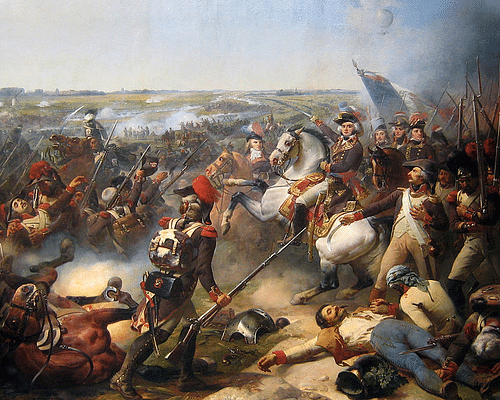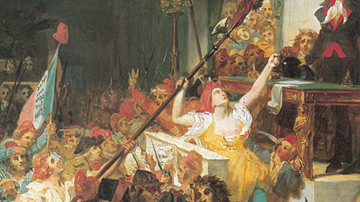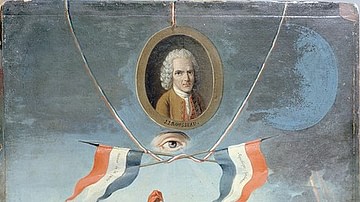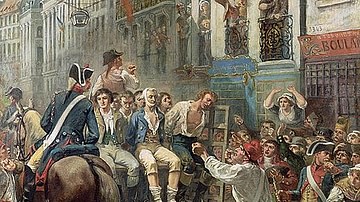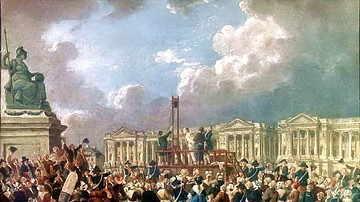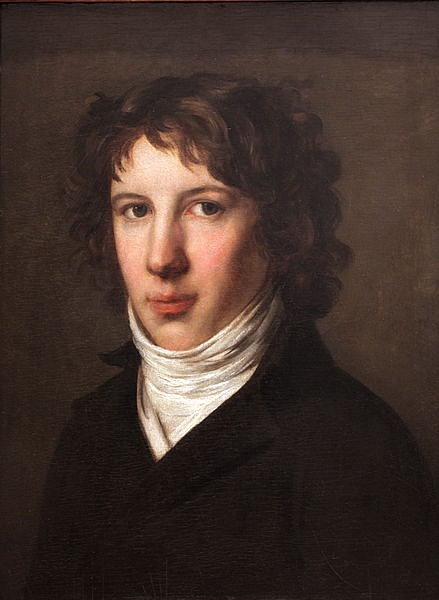
Louis-Antoine de Saint-Just (1767-1794) was a prominent figure of the French Revolution (1789-1799). After his election to the National Convention in September 1792, he led the push for the execution of King Louis XVI of France (r. 1774-1792) and was instrumental in the drafting of radical Jacobin legislation like the Ventôse Decrees and the Constitution of 1793.
Saint-Just was a radical Jacobin leader and the closest ally of Maximilien Robespierre (1758-1794). He is most often associated with the Reign of Terror and was nicknamed the "Archangel of Terror" for his participation in it. He was also an effective military commissar and contributed to the decisive French victory at the Battle of Fleurus. After the fall of Maximilien Robespierre, Saint-Just was guillotined on 28 July 1794, at the age of 26.
Wayward Youth
Louis-Antoine-Léon de Saint-Just was born on 25 August 1767 in Decize, a commune in central France. He was the eldest child of Louis-Jean de Saint-Just de Richebourg, a retired cavalry officer, and Marie-Anne Robinot, daughter of a wealthy notary, and had two younger sisters. In 1776, the family moved to the rural town of Blérancourt, in his father's native province of Picardy. The family quickly established themselves within the local bourgeois elite.
In 1777, the elder Saint-Just died, and Marie-Anne sent her son to the Oratorian college at Soissons in 1779. Here, Saint-Just became known as a troublemaker. After graduation in 1786, he returned to Blérancourt and began to court Thérèse Gellé, the daughter of the town's most powerful notary. The two may have even made plans to marry, but on 25 July, while Saint-Just was away, Thérèse's father married her off to the heir of another wealthy family. When Saint-Just returned, he was furious. Feeling heartbroken and spurned, he ran away to Paris in September, taking with him a good portion of his mother's silver.
Immediately, Marie-Anne contacted the Paris police to track down her son. It did not take long for them to find him, lodging near the Palais-royal, a location notorious for its proximity to brothels and gambling houses. When the police found him, Saint-Just had already run out of money, following what must have been an impressive spending spree. He was arrested and placed in a reformatory in October 1786, where he stayed for six months. He was released in April 1787, after declaring that he was ready to turn his life around. At his mother's insistence, he enrolled in the law school at Reims and took a job clerking for the public prosecutor of Soissons. But his heart was not in his studies, and by 1788, he had dropped out of school and was back living with his mother, penniless and jobless.
He spent his days working on a long narrative poem entitled Organt, a poem in twenty cantos. The poem, following the misadventures of young Antoine Organt, was a combination of political satire and pornography. Saint-Just's critiques of the monarchy, aristocracy, and the Catholic Church were overshadowed by frequent and violent sex scenes that included the raping of nuns. Quite mischievously, he dedicated the book to the Vatican. Saint-Just recognized the immaturity of his work and expressed disappointment with himself in the preface to Organt which read: "I am twenty; I have acted badly; but I shall do better" (Scurr, 132). And so, with hopes of a literary future, Saint-Just headed to Paris in the spring of 1789 to find publication and success. What he found instead was revolution.
Young Revolutionary
Saint-Just arrived in Paris in May 1789, the same month that France's social tensions and financial troubles finally boiled over. He managed to get Organt published, although it was an instant failure; when the book was banned and police were sent to confiscate it from bookstores, they found that most stores had already declined to sell it. Saint-Just lingered in Paris until the end of July, witnessing the rising upheaval that culminated in the Storming of the Bastille. By the time he returned to Blérancourt, his literary ambitions had been replaced with new ones; he now dreamed of being a revolutionary.
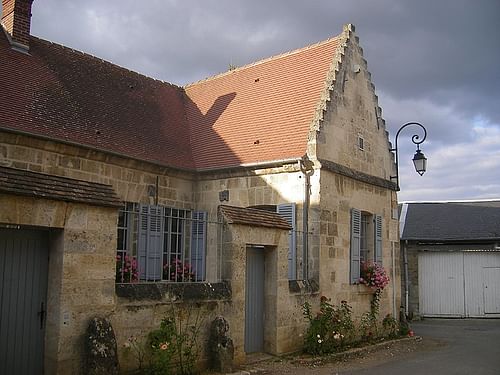
The rising tide of revolution swept into Blérancourt on Saint-Just's coattails. In early 1790, a group of local radicals that included some of Saint-Just's friends were elected to the town council. As Saint-Just was too young to stand for office himself, he joined his local unit of the National Guards and used his new connections in the town council to be appointed lieutenant-colonel. In this capacity, he represented Blérancourt at the Festival of the Federation in Paris, which celebrated the first anniversary of the fall of the Bastille. Yet, Saint-Just's ambitions were not satisfied, and he set his sights on a seat in the National Assembly, the representative body at the heart of the revolution. Since he was ineligible for election until the age of 25, he resolved to cultivate a reputation so that he could be elected as soon as he came of age.
He began with a display of theatrics. Claiming to have been sent 30 counter-revolutionary pamphlets, he called a meeting of the town council to discuss what to do about it. When the council voted for the pamphlets to be burned, Saint-Just thrust his own hand into the fire and swore to give his own life for the Revolution if needed. The performance supposedly brought tears to the eyes of those in attendance, and the story made its way to the National Assembly in Paris, which sent Saint-Just a formal letter of congratulations for his patriotism. Taking advantage of his new notoriety, Saint-Just wrote letters to established revolutionaries like Camille Desmoulins (1760-1794) and Maximilien Robespierre (1758-1794). Robespierre was so flattered by Saint-Just's letter that he kept it. It read, in part:
You who uphold our tottering country against the torrent of despotism and intrigue, you who I know, as I know God, only through his miracles – it is to you, monsieur, that I address myself, to entreat you to unite with me in saving my poor land ... I do not know you, but you are a great man. You are not merely the deputy of a province, you are the deputy of the Republic and of mankind. (Scurr, 132).
Clearly, Saint-Just was not averse to using flattery to get ahead. In June 1791, he published his first revolutionary pamphlet, The Spirit of the Revolution, which denounced the violence that had brought about the fall of the Bastille and advocated for peace and stability. In contrast to his later reputation, Saint-Just's pamphlet advocated for a moderate approach to revolution, opposed the death penalty, and called for leniency toward the king. Three days after the pamphlet's publication, King Louis XVI made his fruitless flight to Varennes, an event that destroyed France's remaining trust in the monarchy and led to a new republican movement. Already, Saint-Just's views were outdated; the Revolution was moving at a breakneck pace.
National Convention
After the king's attempted flight, tensions between the people and the monarchy continued to simmer. Finally, on 10 August 1792, the people of Paris overthrew the monarchy in the Storming of the Tuileries Palace. A new representative body, called the National Convention, was summoned to write a new constitution for the now kingless France. Having only just turned 25, Saint-Just stood for election to this new assembly and won; he arrived in Paris that September, the youngest of 749 deputies. Only days later, the Convention announced the creation of the French Republic.

During his first weeks on the Convention, Saint-Just attended meetings of the Jacobin Club but largely refrained from participating in debates. Around this time, the Convention was divided between two rival groups: the moderate Girondins and the extremist Mountain. Both were offshoots from the Jacobin Club but had let their differences drive a deep wedge in the unity of the Revolution. Saint-Just, perhaps waiting to see which way the wind was blowing, did not openly declare for one faction or the other until 13 November 1792, when he delivered the most electrifying maiden speech of the entire Revolution.
The argument of the day was the fate of the deposed king. The Girondins wished to spare the king's life, to potentially keep him as a political pawn. Saint-Just disagreed, believing Louis XVI was guilty of horrific crimes simply by the virtue of being a king, since "no one can reign innocently". For this reason, Saint-Just declared that Louis should die without the benefit of a trial:
I say that the King must be judged as an enemy; that we must not so much judge him as combat him ... someday, men will be astonished that in the 18th-century humanity was less advanced than in the time of Caesar. Then, a tyrant was slain in the midst of the Senate with no formality but thirty dagger blows, with no law but the liberty of Rome. And today, respectfully, we conduct a trial for a man who was the assassin of a people ... for myself, I can see no mean: this man must reign or die. (Scurr, 243)
It was a career-making speech. He frequently had to pause to make room for the rapturous applause that accompanied his words. Robespierre, greatly impressed, gave a speech the following day that echoed Saint-Just's main points; from that day on, the two men remained close friends and allies, and the Mountain began to rally behind their leadership. Saint-Just, young and handsome, with long black hair and a dandyish style of dress, became the darling of the Jacobins; whenever he spoke, spectators pushed to the front of the crowd to catch a glimpse of the revolutionary rockstar.
His oratory helped lead to the trial and execution of Louis XVI on 21 January 1793. The king's death only deepened the hatred between the Girondins and the Mountain, which continued until 2 June, when a popular insurrection led to the purge of the Girondins from the Convention and the arrests of their leaders. The fall of the Girondins left the Mountain in control of the French Republic.
Committee of Public Safety
With the king dead and the Girondins in prison, the Jacobins could finally work on giving France a new constitution. On 24 April 1793, Saint-Just submitted a lengthy proposal that included the right to petition, universal suffrage, and called for elections to be decided by a simple majority. His ideas impressed his colleagues, who assigned him and four others to the task of writing the constitution. In recognition of their important assignment, Saint-Just and his fellow draftsmen were added to the Committee of Public Safety, a powerful new assembly responsible for the defense of France. The constitution was drafted in eight days and was submitted to the National Convention on 10 June. It was accepted by the people in a public referendum.
Yet Saint-Just's work on the Committee of Public Safety was not done. The French Republic was teetering on the abyss, its existence threatened by the armies of several European powers, who had entered into a coalition against the French Revolution, and by the federalist revolts, which had erupted in support of the disgraced Girondins. The Jacobins' response to these existential dangers was to enact a Reign of Terror, in the hopes that counter-revolutionary traitors would be unmasked and brought to justice.
Saint-Just worked with Robespierre, who was added to the Committee on 27 July, and other Jacobin leaders to enact the Law of Suspects, which allowed for the arrest of anyone who appeared counter-revolutionary by their words, writings, or actions. Under this law, 300,000-500,000 French citizens were arrested nationwide; tens of thousands were executed by guillotine or died in prison. On 10 October, Saint-Just officially proposed that the government should remain revolutionary until the peace. Consequently, the new constitution was indefinitely shelved, and more executive powers were heaped onto the Committee of Public Safety, which now exerted near-dictatorial authority.
In October, Saint-Just was sent to Alsace alongside another Jacobin, Philippe-François-Joseph Le Bas, whose sister, Henriette, Saint-Just was secretly dating. The two young men were tasked with revitalizing the French Army of the Rhine, which had grown lethargic in the face of a more professional Austrian army. Saint-Just and Le Bas imposed harsh discipline on the army, at one point even having a general shot in front of his men. They arrested officers and politicians suspected of cowardice or treachery but refrained from imposing mass executions.
Saint-Just, noticing the army was largely barefoot, ordered 10,000 pairs of shoes to be confiscated from aristocrats in the nearby city of Strasbourg and redistributed to soldiers. The city ended up sending 17,000 pairs of shoes and 21,000 shirts. Saint-Just also curbed the authority of the representatives-on-mission, thus reinforcing the idea that the Committee, not the Convention, held supreme power. By the time he and Le Bas left Alsace in December, the army was whipped into shape and began to push the Austrians back.
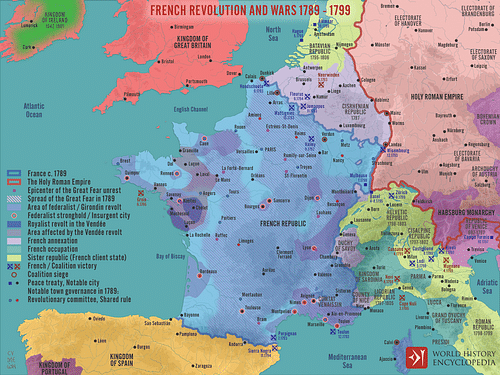
Shortly after returning to Paris, Saint-Just was elected president of the National Convention for a two-week term that lasted from 19 February-6 March 1794. He used that time to draft the Ventôse decrees, a series of proposed decrees that would confiscate the property of aristocrats and counter-revolutionary émigrés, which would be redistributed to needy commoners. Saint-Just argued that enemies of the Revolution had given up their civil rights and could not be landowners. Had these decrees gone into effect, they would have been one of the most revolutionary accomplishments of the French Revolution, since they raised up one class at the expense of another. However, pushback from the Jacobins' opponents, and Saint-Just's subsequent fall from power, meant that the decrees never went into effect.
Archangel of Terror
Saint-Just agreed with Robespierre that Terror was needed to create a virtuous Republic and professed to believe that the blood of counter-revolutionaries must necessarily be spilled. In October 1793, he prepared the death sentences for the Girondin leaders, who were guillotined after a sham trial. When his and Robespierre's control of the Terror was threatened by the 'ultra-revolutionary' Hébertists, Saint-Just worked toward their arrests and executions as well, which occurred in March 1794. Around the same time, Saint-Just denounced Georges Danton (1759-1794), another Jacobin leader who had become the leader of the Indulgents, opponents of the Terror. Saint-Just appeared before the Convention to denounce Danton and accuse him of fomenting insurrection, referring to the Indulgents as the "last partisans of royalism" (Doyle, 272). Danton, Desmoulins, and 13 others were guillotined on 5 April 1794.
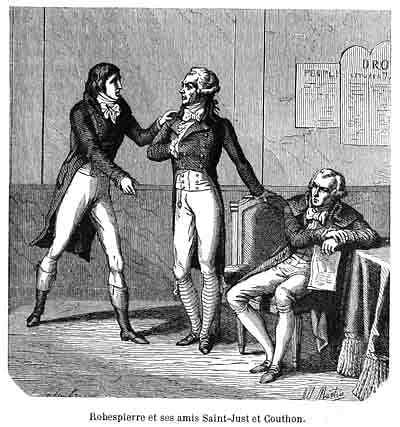
By now, Saint-Just had played a major role in the arrests and executions of three rival factions and was called the "Archangel of Terror". He had become more autocratic and bloodthirsty than any of his colleagues, believing death to be the only suitable punishment for those who opposed the Republic. This was reflected in the Law of 22 Prairial, passed by the triumvirate of Robespierre, Saint-Just, and Georges Couthon (1755-1794), which accelerated the Revolutionary Tribunal's duties and permitted it to render no verdicts besides acquittal or death. Yet, Saint-Just may have been growing uneasy about the incessant slaughter of the Terror, as he privately wrote, "The Revolution is frozen; all principles are weakened" (historytoday.com). It was a private admission of doubt, the despairing conscience of a man who had gone too far to turn back.
Downfall
In the spring of 1794, Saint-Just was sent on several missions to Belgium, where he was instructed to reinvigorate the Army of the North. His efforts contributed to the French victory at the Battle of Fleurus on 26 June 1794, which was arguably the turning point in the War of the First Coalition (1792-1797); afterwards, the French remained victorious for the rest of the war.
Returning to Paris, Saint-Just found that Robespierre's enemies had begun to denounce him on the Convention floor as a murderer and a tyrant. On 26 July, Robespierre spoke in his own defense, claiming to possess a list of traitors in the Convention and the Committee of Public Safety. He refused to name any names, causing an uproar amongst the gathered deputies. On the morning of 27 July, Saint-Just began a speech in defense of Robespierre but was drowned out by a sea of voices calling for his and Robespierre's arrests. The Convention denounced Robespierre and Saint-Just and declared them to be outlaws. By nightfall, the leading Robespierrists were hiding out at the Hôtel de Ville, planning an insurrection to topple the Convention. At 2 a.m. on 28 July, soldiers loyal to the Convention stormed the Hôtel; Le Bas committed suicide, Robespierre attempted to, and Couthon fell from his wheelchair in a desperate attempt to escape. Only Saint-Just accepted his fate and was arrested with stoic dignity.
Later that day, Saint-Just was guillotined alongside Robespierre, Couthon, and 18 of their allies. Shortly before his death, Saint-Just was asked to identify himself; in response, he gestured to a copy of the Constitution of 1793 and proudly said, "I am the one who made that." He was less than a month shy of his 27th birthday. His and Robespierre's executions marked the end of the Reign of Terror, the end of Jacobin dominance, and the beginning of the Thermidorian Reaction.
